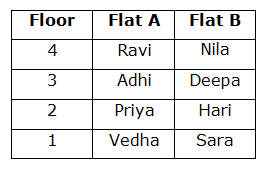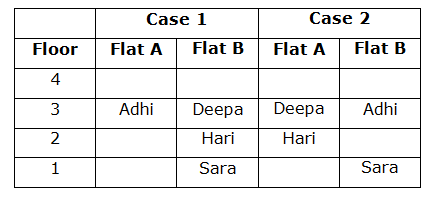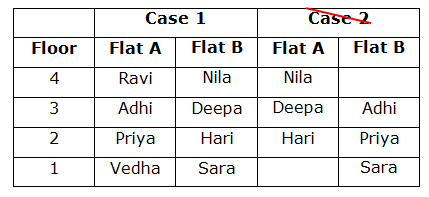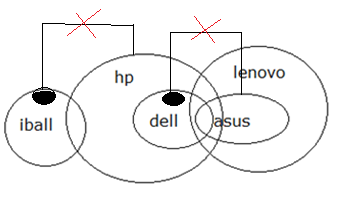Dear Aspirants, Our IBPS Guide team is providing new series of Reasoning Questions for IBPS Clerk Prelims 2021 so the aspirants can practice it on a daily basis. These questions are framed by our skilled experts after understanding your needs thoroughly. Aspirants can practice these new series questions daily to familiarize with the exact exam pattern and make your preparation effective.
Floor with flat puzzle
Direction (1-5): Answer the questions based on the information given below.
Eight persons viz. Adhi, Deepa, Hari, Nila, priya, Ravi, Sara and Vedha were living in two different flats viz. Flat A and Flat B of a four storey building, but not necessarily in the same order. The lowermost floor is numbered 1 and the floor above is numbered 2 and so on. Flat A is to the west of Flat B.
Adhi was living on floor 3 and immediately above Hari in a different flat. Sara was living in flat B on floor 1 and two floors below Deepa. Only one floor is there between Priya and Nila who is living in the same flat along with Deepa. Ravi lives above Vedha in the same flat.
1) In which of the following floor does Ravi lives?
A.2
B.4
C.1
D.3
E.Cannot be determined
2) Who among the following person lives immediately above Sara in the same flat?
A. Priya
B. Deepa
C. Adhi
D .Hari
E. None of these
3) Which of the following statement is true with respect to the final arrangement?
A. No floors are there above Priya
B. Ravi and Nila doesn’t live on the same floor
C. Vedha lives in the same flat as Priya
D. Hari and Ravi live on the same floor
E. None of these
4) Which of the following position is correct with respect to Priya?
A. On the same floor as Ravi
B. Immediately above Sara on the same flat
C. Two floors below Adhi on different flat
D. On the bottommost floor
E. None of these
5) In which of the following floor and flat does Deepa lives?
A. Floor 3, flat B
B. Floor 4, flat A
C. Floor 3, flat A
D. Floor 4, flat B
E. None of these
Inequality
Direction (6-7): In each of the following questions, the relationship between different elements is shown in the statements followed by some conclusions. Find a conclusion which logically follows.
6) Statement:
P ≤ Y ≥ J ; L = U < O; I > L ≤ G = Y
Conclusion:
I). O > I
II). G ≥ J
III). U = Y
A. Only I follows
B. Only II follows
C. Only III follows
D. All follow
E. None follows
7) Statement:
M < S < A < C ; O ≥ C = T ≥ B; K ≥ L > T > V
Conclusion:
I). K = B
II). A < L
III). K > B
A. Only II follows
B. Only III follows
C. Both II and III follow
D. Only II and either I or III follow
E. None follows
Syllogism
Direction (8-10): Read the conclusions and then decide which of the given conclusions logically follows from the two given statements, disregarding commonly known facts.
(a) If only I conclusion follows
(b) If only II conclusion follows
(c) If either I or II follows
(d) If neither I nor II follows and
(e) If both I and II follow
8) Statements:
Only a few papers is plastic
No plastic is pen
All pens are eraser
All erasers are ink
Conclusions:
I). All paper can never be ink
II). All pen can never be plastic is a possibility
9) Statements:
Only a few ruby is emerald
Only a few emeralds is diamond
All ruby is silver
No diamond is silver
Conclusions:
I). All silver can never be ruby
II). Few diamond can be silver
10) Statements:
Only a few iball is hp
All dell is hp
Only a few dell is asus
All asus is Lenovo
Conclusions:
I). All iball is Lenovo is a possibility
II).Few asus is hp
Answers :
Directions (1-5) :

1) Adhi was living on floor 3 and immediately above Hari in a different flat. Sara was living in flat B of floor 1 and two floors below Deepa.

2) Only one floor is there between Priya and Nila who is living in the same flat along with Deepa. Ravi lives above Vedha in the same flat. Hence, case 2 gets eliminated.

1) Answer: B
2) Answer: D
3) Answer: C
4) Answer: E
5) Answer: A
6) Answer: B
I). O > I –> O > U = L < I –>False
II). G ≥ J –> G = Y ≥ J –>True
III). U = Y –> U = L ≤ G = Y –>False
Hence, Option B is correct.
7) Answer: C
I). K = B –> K ≥ L > T ≥ B –>False
II). A < L –> A < C = T < L –>True
III). K > B –> K ≥ L > T ≥ B –>True
Hence, Option C is correct.
8) Answer: D

9) Answer: D

10) Answer: E






